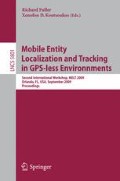Abstract
Recently, cooperative robotic applications have attracted considerable attention. Cooperative assignments for robots demand accurate localization. Since in an indoor environment localization using GPS does not render a satisfactory result, we need to resort to different approaches for indoor geolocation. Precise localization information means better coordination that enables us to manipulate robots more effectively for variety of tasks. In this paper, the cooperative localization performance accuracy for a multi-robot operation is examined using empirical models for ranging estimates in an indoor environment scenario at the third floor of the Atwater Kent Laboratory (AKL) in the Worcester Polytechnic Institute. The two widely used ranging techniques are Time Of Arrival (TOA) using Ultra-wideband (UWB) and Received Signal Strength (RSS) using WiFi signals. We use empirical statistical models for UWB TOA-based and WiFi RSS-based operations in order to determine the Cramé r-Rao-Lower-Bound (CRLB) on the performance of localization techniques in our multi-robot operation scenarios. We determine the performance of the localization of robots when they are localized individually versus when they are benefited from cooperative localization.
Access this chapter
Tax calculation will be finalised at checkout
Purchases are for personal use only
Preview
Unable to display preview. Download preview PDF.
References
Spletzer, J., Das, A.K., Fierro, R., Taylor, C.J., Kumar, V., Ostrowski, J.P.: Cooperative localization and control for multi-robot manipulation. In: Proceedings of 2001 IEEE/RSJ International Conference on Intelligent Robots and Systems, 2001, 29 October-3 November 2001, vol. 2, pp. 631–636 (2001)
Rekleitis, I.M., Dudek, G., Milios, E.E.: Multi-robot cooperative localization: a study of trade-offs between efficiency and accuracy. In: IEEE/RSJ International Conference on Intelligent Robots and System, 2002, 30 September-5 October 2002, vol. 3, pp. 2690–2695 (2002)
Pahlavan, K., Akgul, F.O., Heidari, M., Hatami, A., Elwell, J.M., Tingley, R.D.: Indoor geolocation in the absence of direct path. IEEE Wireless Communications 13(6), 50–58 (2006)
Pahlavan, K., Li, X., Makela, J.P.: Indoor geolocation science and technology. IEEE Communications Magazine 40(2), 112–118 (2002)
Pahlavan, K.: WiFi and UWB RF Localization-Principles and Applications. In: Pahlavan, K. (ed.) IEEE Short Course. PIMRC 2006, Helsinki, Finland (September 2006)
Silverstrim, J., Passmore, R., Pahlavan, K., Sadler, B.: Wireless sensor networks with geolocation. Defense Tech. Briefs 3(3), 14–15 (2009)
Hatami, A., Pahlavan, K.: Performance Comparison of RSS and TOA Indoor Geolocation Based on UWB Measurement of Channel Characteristics. In: 17th Annual IEEE International Symposium on Personal Indoor and Mobile Radio Communications (PIMRC 2006), Helsinki, Finland (September 11-14, 2006)
Alsindi, N.A.: Cooperative Localization Bounds for Indoor Ultra-Wideband Wireless Sensor Networks. Hindawi Publishing Corporation EURASIP Journal on Advances in Signal Processing 2008, Article ID 852509, 13 pages
Alavi, B., Pahlavan, K.: Modeling of the TOA-based distance measurement error using UWB indoor radio measurements. Communications Letters, IEEE 10(4), 275–277 (2006)
Qi, Y., Kobayashi, H.: On relation among time delay and signal strength based geolocation methods. In: Global Telecommunications Conference, 2003. GLOBECOM 2003, December 2003, vol. 7(1-5), pp. 4079–4083 (2003)
Savvides, A., Garber, W.L., Moses, R.L., Srivastava, M.B.: An analysis of error inducing parameters in multihop sensor node localization. IEEE Transactions on Mobile Computing 4(6), 567–577 (2005)
Kaveh, P., Allen, H.L.: Wireless Information Networks, 2nd edn., p. 738. Wiley & Sons, Inc., Chichester (2005)
Gezici, S., Tian, Z., Giannakis, G.B., Kobayashi, H., Molisch, A.F., Poor, H.V., Sahinoglu, Z.: Localization via ultra-wideband radios. In: IEEE Signal Processing Magazine (Special Issue on Signal Processing for Positioning and Navigation with Applications to Communications), July 2005, vol. 22(4), pp. 70–84 (2005)
Author information
Authors and Affiliations
Editor information
Editors and Affiliations
Rights and permissions
Copyright information
© 2009 Springer-Verlag Berlin Heidelberg
About this paper
Cite this paper
Bargshady, N., Alsindi, N.A., Pahlavan, K. (2009). Performance of TOA- and RSS-Based Indoor Geolocation for Cooperative Robotic Applications. In: Fuller, R., Koutsoukos, X.D. (eds) Mobile Entity Localization and Tracking in GPS-less Environnments. MELT 2009. Lecture Notes in Computer Science, vol 5801. Springer, Berlin, Heidelberg. https://doi.org/10.1007/978-3-642-04385-7_17
Download citation
DOI: https://doi.org/10.1007/978-3-642-04385-7_17
Publisher Name: Springer, Berlin, Heidelberg
Print ISBN: 978-3-642-04378-9
Online ISBN: 978-3-642-04385-7
eBook Packages: Computer ScienceComputer Science (R0)

